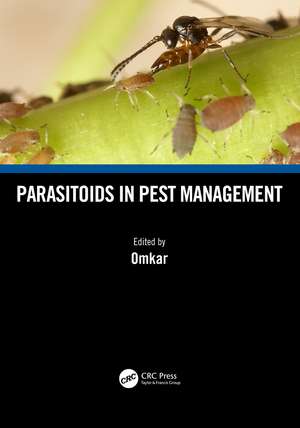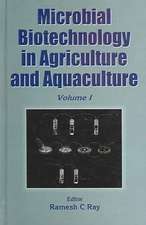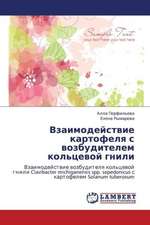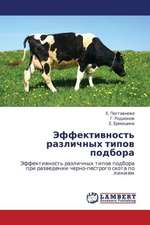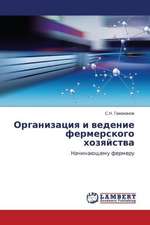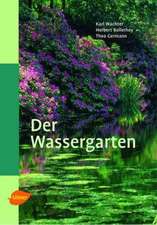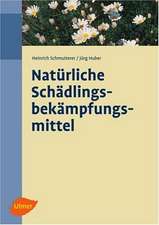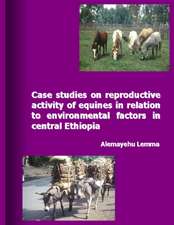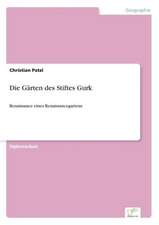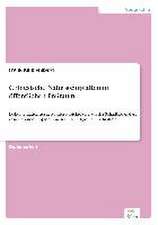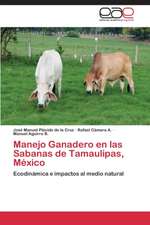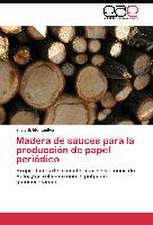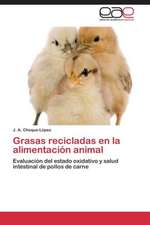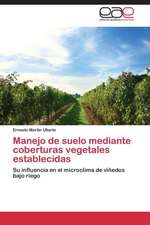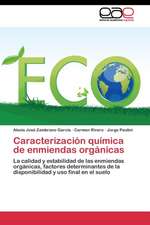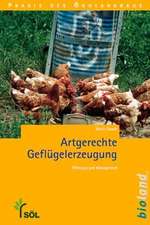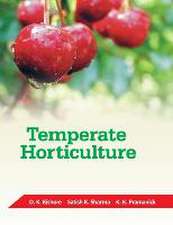Parasitoids in Pest Management
Editat de Omkaren Limba Engleză Hardback – 13 mar 2023
This book covers information on the important biocontrol agents effective in pest suppression. It starts with insect parasitic groups followed by specific groups of parasitoids. It is hoped that the book presents a comprehensive account of beneficial parasitoirds, and will be useful to undergraduate and postgraduate students of Entomology, Biological Control, Plant Protection, Agricultural Zoology, and Zoology, besides those involved in competitive examinations and policy planning.
Features:
- Each chapter has been written by very experienced specialists
- Every chapter includes Learning Objectives and Points to Remember
- This book offers comprehensive knowledge of parasitoids and their application in pest management in a rational way
Preț: 848.97 lei
Preț vechi: 1035.33 lei
-18% Nou
Puncte Express: 1273
Preț estimativ în valută:
162.46€ • 167.85$ • 135.14£
162.46€ • 167.85$ • 135.14£
Carte tipărită la comandă
Livrare economică 20 martie-03 aprilie
Preluare comenzi: 021 569.72.76
Specificații
ISBN-13: 9781032406701
ISBN-10: 1032406704
Pagini: 370
Ilustrații: 20 Tables, black and white; 9 Line drawings, black and white; 47 Halftones, black and white; 56 Illustrations, black and white
Dimensiuni: 178 x 254 x 22 mm
Greutate: 0.8 kg
Ediția:1
Editura: CRC Press
Colecția CRC Press
Locul publicării:Boca Raton, United States
ISBN-10: 1032406704
Pagini: 370
Ilustrații: 20 Tables, black and white; 9 Line drawings, black and white; 47 Halftones, black and white; 56 Illustrations, black and white
Dimensiuni: 178 x 254 x 22 mm
Greutate: 0.8 kg
Ediția:1
Editura: CRC Press
Colecția CRC Press
Locul publicării:Boca Raton, United States
Public țintă
Postgraduate and ProfessionalCuprins
1. Insect Parasitoids- Mani Chellappan and Ranjith MT
Learning Objectives, Abstract, Keywords, Introduction, Order: Diptera, Family: Cecidomyiidae, Nemestrinidae, Bombyliidae, Asilidae, Phoridae, Pipenculidae, Tachinidae, Sarcophagidae, Order: Coleoptera: Family: Carabidae, Scarabidae, Rhipiceridae, Cleridae, Rhipiphoridae, Meloidae, Passandridae, Bothrediridae, Curculionidae, Order: Lepidoptera: Family-Epipyropidae, Cyclotornidae, Order: Hymenoptera: Family: Braconidae, Ichneumonidae, Mymaridae, Trichogrammatidae, Eulophidae, Elasmidae, Pteromalidae, Encyrtidae, Aphelinidae, Eupelmidae, Chalcididae, Eurytomidae, Torymidae, Ormyridae, Leucopsidae, Euchartidae, Perilampidae, Signiphoridae, Eucoilidae, Figitidae, Platygatseridae, Scelonidae, Bethylidae, Order: Neuroptera, Family: Mantispidae, Conclusions, Points to Remember, References.
2. Ichneumonid Parasitoids- Longjam Roni Kumar Singh, Devanshu Gupta & Kailash Chandra
Learning Objectives, Abstract, Keywords, Introduction, Systematic account, Life history, Biological control utilizing Ichneumonidae, Notes on the subfamilies of Indian Ichneumonidae, Mass Rearing, Conclusions, Points to Remember, References.
3. Braconid Parasitoids- Ankita Gupta
Learning Objectives, Abstract, Keywords, Introduction, Diagnosis and key characters, Classification- subfamily and tribes, List of subfamilies and tribes reported from India, Molecular characterisation and phylogeny, Morphological and Molecular Phylogenetic Analysis of the genus Glyptapanteles, Biodiversity and species richness, Morphological and Molecular Phylogenetic Analysis of the genus Glyptapanteles, Biology, Host- parasitoid association, Braconid parasitoids of recent invasive pest, Morphological and Molecular Phylogenetic Analysis of the genus Glyptapanteles, Immature taxonomy, Integrative taxonomy, Taxonomic problems, Economic importance, Collection and preservation techniques,Workers on Indian Fauna, Conclusions, Points to Remember, References.
4. Aphidiine Parasitoids (Braconidae-Hymenoptera)- B.C. Das & Samiran Chakrabarti
Learning Objectives, Abstract, Keywords, Introduction, Diversity and Zoogegraphical distribution, Fossil aphidiines, Collection, rearing and identification, Biology, Foraging, Hyperparasitoids, Diapause, Host parasitoid relationship, Population dynamics, Effective aphidiine biocontrol agents, Mass rearing, Constraints of using aphidiines in biological control, Conclusions, Points to Remember, References.
5. Pteromalid Parasitoids-Arvind Kumar, Aishwarya Ray & Meena Agnihotri
Learning Objectives, Abstract, Keywords, Introduction, Identifications features, Brief history and Systematic position, Diversity of Pteromalidae, Biology, Effective biocontrol agents, Mass rearing, Conclusions, Points to Remember, References.
6. Encyrtid Parasitoids-P.S. Shera, Sudhendu Sharma, Prasun Karmakar & Sudhir Singh
Learning Objectives, Abstract, Keywords, Introduction, Characteristics of Encyrtidae, Biology, Effective Encyrtid biocontrol agents, Mass rearing of important Encyrtid parasitoids, Case studies, Conclusions, Points to Remember, References.
7. Chalcidoid Parasitoids- Sureshan, P M & S P. Girish Kumar
Learning Objectives, Abstract, Keywords, Introduction, Diversity and distribution of chalcids, Common and effective parasitoids and their hosts, Characteristics of effective biocontrol agents, Rearing techniques, mass production and field application, Threat and conservation status, Conclusions, Points to Remember, References.
8. Eulophid Parasitoids- Meena Agnihotri, J. M. Samraj & Arvind Kumar
Learning Objectives, Abstract, Keywords, Introduction, Basic characters for identification, Diversity and biology, History of eulophid research, Taxonomic position of Eulophidae, Studies on eulophid fauna of the world, Eulophid research in India, Exploration of eulophids as biocontrol agents, Host parasitoid index of Eulophid parasitoids in India, Mass rearing of important eulophid parasitoids, Successful biocontrol agents, Conclusions, Points to Remember, References.
9. Trichogrammatid Parasitoids-Omprakash Navik, Richa Varshney, Y. Lalitha & S. K. Jalali,
Learning Objectives, Abstract, Keywords, Introduction, Systematics, History and classification, Size and distribution, Diversity and host range, Biology, Ecology and behavior, Geographical strains, Improvement of trichogrammatids, Mass production and biological control, Release strategies of trichogrammatids, Conclusions Points to Remember, References.
10. Scelionid Parasitoids- Mohana, S Kumar & Sunita Patra
Learning Objectives, Abstract, Keywords, Introduction, Diversity of Scelionidae, Characteristics of Scelionidae, Diversity of Scelionids, Biology, Effective scelionid biocontrol agents, Scelionids in Classical Biocontrol Programs, Conclusions, Points to Remember, References.
11. Aphelinid Parasitoids- Mani Chellappan & Ranjith, M. T.
Learning Objectives, Abstract, Keywords, Introduction, Distribution and diversity, Biology, Hosts of Aphelinid parasitoids, Important parasitoids, Mass production, Role in Biocontrol, Field release across globe, Success stories, Conclusions, Points to Remember, References.
12. Beneficial Diptera-Dhriti Banerjee, Atanu Naskar & Jayita Sengupta
Learning Objectives, Abstract, Keywords, Introduction, Phylogeny and classification, Habits and Habitat, Ecosystem services, Life cycle and developmental stages, Feeding Behaviour, Carnivory in Diptera: Predators, Parasites and Parasitoids, Evolution of carnivory in Diptera, Diptera Predators, Diptera Parasitoids, Biology of Diptera parasitoids, Rearing, mass production, and field application of Diptera parasitoids, In-vivo rearing technique, In-vitro rearing technique, Adult rearing and management, Storage and transportation of reared flies, The Future of Dipterans as biocontrol agents, , Conclusion: Conservation of beneficial Diptera for sustainable development, Points to Remember, References.
Learning Objectives, Abstract, Keywords, Introduction, Order: Diptera, Family: Cecidomyiidae, Nemestrinidae, Bombyliidae, Asilidae, Phoridae, Pipenculidae, Tachinidae, Sarcophagidae, Order: Coleoptera: Family: Carabidae, Scarabidae, Rhipiceridae, Cleridae, Rhipiphoridae, Meloidae, Passandridae, Bothrediridae, Curculionidae, Order: Lepidoptera: Family-Epipyropidae, Cyclotornidae, Order: Hymenoptera: Family: Braconidae, Ichneumonidae, Mymaridae, Trichogrammatidae, Eulophidae, Elasmidae, Pteromalidae, Encyrtidae, Aphelinidae, Eupelmidae, Chalcididae, Eurytomidae, Torymidae, Ormyridae, Leucopsidae, Euchartidae, Perilampidae, Signiphoridae, Eucoilidae, Figitidae, Platygatseridae, Scelonidae, Bethylidae, Order: Neuroptera, Family: Mantispidae, Conclusions, Points to Remember, References.
2. Ichneumonid Parasitoids- Longjam Roni Kumar Singh, Devanshu Gupta & Kailash Chandra
Learning Objectives, Abstract, Keywords, Introduction, Systematic account, Life history, Biological control utilizing Ichneumonidae, Notes on the subfamilies of Indian Ichneumonidae, Mass Rearing, Conclusions, Points to Remember, References.
3. Braconid Parasitoids- Ankita Gupta
Learning Objectives, Abstract, Keywords, Introduction, Diagnosis and key characters, Classification- subfamily and tribes, List of subfamilies and tribes reported from India, Molecular characterisation and phylogeny, Morphological and Molecular Phylogenetic Analysis of the genus Glyptapanteles, Biodiversity and species richness, Morphological and Molecular Phylogenetic Analysis of the genus Glyptapanteles, Biology, Host- parasitoid association, Braconid parasitoids of recent invasive pest, Morphological and Molecular Phylogenetic Analysis of the genus Glyptapanteles, Immature taxonomy, Integrative taxonomy, Taxonomic problems, Economic importance, Collection and preservation techniques,Workers on Indian Fauna, Conclusions, Points to Remember, References.
4. Aphidiine Parasitoids (Braconidae-Hymenoptera)- B.C. Das & Samiran Chakrabarti
Learning Objectives, Abstract, Keywords, Introduction, Diversity and Zoogegraphical distribution, Fossil aphidiines, Collection, rearing and identification, Biology, Foraging, Hyperparasitoids, Diapause, Host parasitoid relationship, Population dynamics, Effective aphidiine biocontrol agents, Mass rearing, Constraints of using aphidiines in biological control, Conclusions, Points to Remember, References.
5. Pteromalid Parasitoids-Arvind Kumar, Aishwarya Ray & Meena Agnihotri
Learning Objectives, Abstract, Keywords, Introduction, Identifications features, Brief history and Systematic position, Diversity of Pteromalidae, Biology, Effective biocontrol agents, Mass rearing, Conclusions, Points to Remember, References.
6. Encyrtid Parasitoids-P.S. Shera, Sudhendu Sharma, Prasun Karmakar & Sudhir Singh
Learning Objectives, Abstract, Keywords, Introduction, Characteristics of Encyrtidae, Biology, Effective Encyrtid biocontrol agents, Mass rearing of important Encyrtid parasitoids, Case studies, Conclusions, Points to Remember, References.
7. Chalcidoid Parasitoids- Sureshan, P M & S P. Girish Kumar
Learning Objectives, Abstract, Keywords, Introduction, Diversity and distribution of chalcids, Common and effective parasitoids and their hosts, Characteristics of effective biocontrol agents, Rearing techniques, mass production and field application, Threat and conservation status, Conclusions, Points to Remember, References.
8. Eulophid Parasitoids- Meena Agnihotri, J. M. Samraj & Arvind Kumar
Learning Objectives, Abstract, Keywords, Introduction, Basic characters for identification, Diversity and biology, History of eulophid research, Taxonomic position of Eulophidae, Studies on eulophid fauna of the world, Eulophid research in India, Exploration of eulophids as biocontrol agents, Host parasitoid index of Eulophid parasitoids in India, Mass rearing of important eulophid parasitoids, Successful biocontrol agents, Conclusions, Points to Remember, References.
9. Trichogrammatid Parasitoids-Omprakash Navik, Richa Varshney, Y. Lalitha & S. K. Jalali,
Learning Objectives, Abstract, Keywords, Introduction, Systematics, History and classification, Size and distribution, Diversity and host range, Biology, Ecology and behavior, Geographical strains, Improvement of trichogrammatids, Mass production and biological control, Release strategies of trichogrammatids, Conclusions Points to Remember, References.
10. Scelionid Parasitoids- Mohana, S Kumar & Sunita Patra
Learning Objectives, Abstract, Keywords, Introduction, Diversity of Scelionidae, Characteristics of Scelionidae, Diversity of Scelionids, Biology, Effective scelionid biocontrol agents, Scelionids in Classical Biocontrol Programs, Conclusions, Points to Remember, References.
11. Aphelinid Parasitoids- Mani Chellappan & Ranjith, M. T.
Learning Objectives, Abstract, Keywords, Introduction, Distribution and diversity, Biology, Hosts of Aphelinid parasitoids, Important parasitoids, Mass production, Role in Biocontrol, Field release across globe, Success stories, Conclusions, Points to Remember, References.
12. Beneficial Diptera-Dhriti Banerjee, Atanu Naskar & Jayita Sengupta
Learning Objectives, Abstract, Keywords, Introduction, Phylogeny and classification, Habits and Habitat, Ecosystem services, Life cycle and developmental stages, Feeding Behaviour, Carnivory in Diptera: Predators, Parasites and Parasitoids, Evolution of carnivory in Diptera, Diptera Predators, Diptera Parasitoids, Biology of Diptera parasitoids, Rearing, mass production, and field application of Diptera parasitoids, In-vivo rearing technique, In-vitro rearing technique, Adult rearing and management, Storage and transportation of reared flies, The Future of Dipterans as biocontrol agents, , Conclusion: Conservation of beneficial Diptera for sustainable development, Points to Remember, References.
Notă biografică
Prof. Omkar, FNASc, has been associated with teaching for about 35 years and research for more than 42 years. He is Former Head, Department of Zoology, University of Lucknow, Lucknow-226007, Former Coordinator, UGC-SAP (DRS-II), DST-FIST, DST-PURSE, Centre of Excellence, Govt. of UP, programs. He has worked on 10 more projects of state/central funding agencies. He specializes in Environmental Toxicology and Entomology, with particular reference to the Insect Pest Management. He is Chief Editor, Journal of Applied Bioscience, and President, International Society of Applied Biology.
Recenzii
"With the ever-increasing shift in agricultural paradigms from extensive use of insecticides to safer alternatives, interest in biocontrol options in integrated pest management (IPM) programs continues to grow. In this volume specialists provide a broad overview of the role of insect parasitoids in IPM. For each insect group considered as prospective biocontrol agent, the authors draw attention to taxonomy, natural history, host specificities, and management practices (e.g., mass rearing, dissemination, efficacy). The extent of discussion varies from group to group, depending on what is known about a particular taxon. This is an interesting and valuable text that will be of considerable importance to ecologists, conservationists, agriculturalists, and entomologists working in pest management. This is a companion volume to Insect Predators in Pest Management, also edited by Omkar (2023)."
--D. A. Brass, independent scholar, Choice March 2024
--D. A. Brass, independent scholar, Choice March 2024
Descriere
This book covers information on one of the most important biocontrol agents that are effective in controling insect pests of crops. It deals with important insect parasitic groups followed by specific group of parasitoids. The book addresses unique and modern aspects of why insect-pest management is necessary and what are different parastoids.
